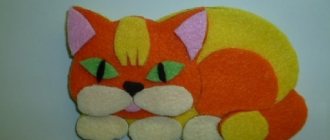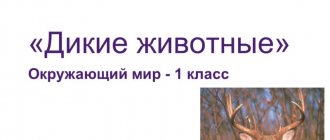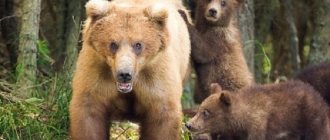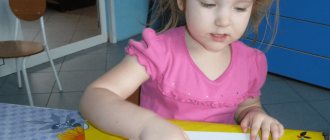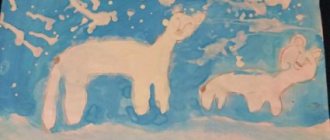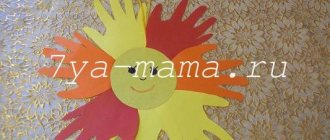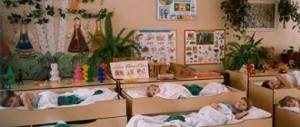Unregulated activity “Domestic animals and their young”
Communication "Pets and their babies"
Monday
Conversation “Who says what?”
Goal: to form an idea about domestic animals.
Tuesday
Story from experience “Which animal do you have at home?”
Goal: to encourage conversations about animals in the house.
Wednesday
Conversation “What kind of domestic animals live in the village?”
Goal: to form an idea about domestic animals living in rural areas.
Thursday
Sketch “Funny Animals”
Goal: development of the child’s emotional sphere.
Friday
Reasoning “What animal?”
Goal: to develop the ability to name domestic animals and their babies and characterize them.
Cognitive practical activity “Domestic animals and their young”
Monday
Looking at pictures of pets
Goal: development of the cognitive sphere of children in conditions of cognitive activity.
Tuesday
Cat watching
Purpose: to clarify the features of appearance; developing the ability to identify and name the main parts of the body, tell what it eats, how it moves, what sounds it makes; consolidating the idea that this pet lives next to a person.
Wednesday
Looking at fish in an aquarium
Goal: to form a general idea in children about fish.
Thursday
Watching the dog
Purpose: to clarify the features of appearance; developing the ability to tell what it eats, how it moves, what sounds it makes; consolidating the idea that this pet lives next to a person.
Friday
Looking at pictures of baby pets
Goal: development of the cognitive sphere of children in conditions of cognitive activity.
Game activity “Pets and their babies”
Monday
Story game “Animal Hospital”
Goal: formation of gaming skills, development of gaming actions.
Tuesday
Didactic game “Who is screaming?”
Goal: development of auditory perception, the ability to name domestic animals and their cubs.
Wednesday
Theatrical game “Kids and the Wolf”
Goal: formation of experience of moral behavior; stimulating the development of creative activity and independence; creating a favorable atmosphere that arouses interest in communication.
Thursday
Outdoor game “Mice and cat”
Goal: development of speed, dexterity, ability to dodge, and to develop the skill of joint gaming activities.
Friday
Didactic game “Whose kids are these?” “Find mom”, “Whose baby?”
Goal: developing the ability to name domestic animals and their babies.
Artistic activity “Pets and their babies”
Monday
Drawing “Pussy walks around the yard, leaves marks”
Goal: development of creative abilities.
Tuesday
Reading Russian folk tales “The Little Goats and the Wolf”, “The Fox and the Goat”
Goal: developing the ability to perceive works of Russian folklore.
Wednesday
Reading Belarusian folk tales “Kaza-manyuka”, “Kotsik, peunik and fox”
Goal: developing the ability to perceive works of Belarusian folklore.
Thursday
Stencils “Pets”
Goal: to develop the ability to paint accurately.
Friday
Making riddles about pets
Goal: developing the ability to name domestic animals and their young by their characteristic features.
Summary of GCD in the second group of early age. Topic: "Pets."
Summary of GCD in the second group of early age.
Subject:
"Pets".
Target:
systematizing children's knowledge about domestic animals and their cubs.
Tasks:
Educational:
Introduce children to domestic animals and their cubs: cat, kitten; dog, puppy; cow, calf; classification of objects by size “large” “small”. Teach children to name animals. To form the skill of dialogical speech, develop the sound culture of speech, continue to enrich the vocabulary, and activate the “passive” vocabulary of children. Teach onomatopoeia.
Developmental: development of thinking, visual attention, integrity of perception, auditory attention, auditory perception;
Educational: to cultivate emotional responsiveness and a desire to communicate, interest in activities, to cultivate in children good relationships with animals, to show a desire to take care of them.
Materials and equipment:
magnetic board, story pictures depicting a cat, dog, cow, and their cubs, musical accompaniment (pet sounds), demonstration pet toys, box, “Glade” layout, “Village House” layout.
Progress of the lesson:
Educator: Good morning, guys! I have something interesting for you. I want to tell you that we have guests today. Let's meet them. To do this, we need to listen carefully to who came to us first (music accompaniment with the characteristic sound of a cat meowing is turned on). The children are listening.
Educator: Who came to us first?
Children: Cat
Educator: Correct. The cat came to us first. We need to find her in our group. Where did she hide? The children and the teacher find the cat. They examine it (here are the cat’s eyes, here are the paws, here is the tail, here are the ears). They invite the cat to the house (model “Country House”). Educator: Let's play with the cat.
Exercise “Cat”.
Clench your two palms into fists at the same time and place them on the table, then simultaneously straighten your fingers and press your palms to the table. Repeat 3-5 times.
Fist - palm. I walk like a cat.
Educator: Guys, the cat didn’t come to us alone. Who came to us second? (music accompaniment with the characteristic sound of a dog barking is turned on). The children are listening.
Children: Dog.
Educator: That's right, it's a dog. Let's invite her too.
We need to find her in our group. Where did she hide? The children and the teacher find the dog. They examine it (here are the dog’s eyes, here are the paws, here is the tail, here are the ears). They invite the dog to the house (model “Village House”). Educator: Our dog is feeling sad, guys, let's play a game with her. Game "Bug".
Summary of a game lesson in the 2nd junior group of kindergarten. Pets
Summary of a game lesson in the 2nd junior group of kindergarten.
Topic: “Pets” Author: Kovalenko Elena Nikolaevna, teacher of the MBDOU kindergarten “FAIRY TALE” in the city of Gornyak, Altai Territory.
Goals: Educational: Continue to introduce children to domestic animals and their babies. Enrich children's vocabulary on the topic. Practice onomatopoeia. Teach children to answer the teacher’s questions, to use nouns in speech that denote animals in units. and many more number. Learn to tear paper into strips. Develop thinking, visual and auditory concentration, fine motor skills, coordination of movements, sense of rhythm. Developmental: develop dialogical speech, attention, memory. Educators: to cultivate interest and love for pets Methods: visual (showing illustrations and toys), verbal (conversation, artistic expression, play), creating a game situation, practical: d/i “Who is missing.” Techniques: questions to children, explanations, instructions, repeated pronunciation. Vocabulary work: horse, cow, mane, lamb. Preliminary work : playing with animal toys, reading fiction about animals, looking at books and pictures on the topic “Pets.” Equipment: Pet toys, chest.
Strips of green paper. Cereals, spoons, jars. Multi-colored clothespins, colored silhouette pictures of kids' heads. Progress of the lesson.
Educator: Today we will go to visit our grandparents in the village and find out who lives with them. Become a locomotive one after another: The locomotive hummed and the carriages were transported Chuh - chukh - chukh - chuh I'll rock you far - ooh - ooh - ooh! (children sit on chairs) Part II Educator : Here we are (picture of grandparents). Grandfather and grandmother live with animals. What are they called? (picture of a farm with pets). And we will find out which ones when we take them out of the chest. Surprise moment “Wonderful chest” “Here is a wonderful chest, I really want to know how you like to play!” Didactic game “Who lives on the farm? Children put their hand into a wonderful bag and take turns taking out pet toys and calling them. 1. Cow A cow has horns and hooves on its legs. She chews grass and gives milk to the children. — The cow has a child, what is it called? (calf). As the calf says (“Moo-oo-oo”). Say it like the calf says. Are there many people in this picture? (Lots of calves). Bloodies love to eat grass, let's pick some for her. Let's pick some grass “Grass for a cow” Children tear a strip of green paper with their fingers.
2. Pig The dirty pig has bristles on its back, a snout on its face, and a thin hooked tail on its back. - A pig's child is called a piglet. The pig says: “oink-oink.” Say it like the pig says. Are there many people in this picture? (Lots of piglets) Exercise “Fill the feeder for the piglets” Children fill multi-colored soap dish-feeders with buckwheat with a spoon. (Take it with a spoon from a common cup and pour it into your own jar).
3. Horse The horse has a long mane and has a cheerful and playful disposition. She will eat the hay now and give us a ride. - A horse's child is called a foal. The foal says: “i-go-go.” Say it like a foal says. Are there many people in this picture? (Many foals) Didactic game “What can a horse do?” — Do you know how to clearly say the word “yes”? Tell. Now say the word “no.” You did well, play an interesting game with me. I will ask you what the horse can do, and you think and answer: if the horse can do it, say “yes.” And if the horse doesn't know how to do it, say no. Can the horse gallop fast? Can a horse fly in the sky? Can a horse chew grass? Can a horse clatter its hooves? Does your horse know how to play with toys? The horse can neigh loudly: yoke? 4. Rabbits The long-eared rabbit will not hurt the flies. There are always carrots and water in his cage. - A rabbit's baby is called a baby rabbit.
Physical school Children stand in a circle. Skok-skok, skok-skok The rabbit jumped onto a stump. He beats the drum loudly and invites everyone to warm up. Paws up, paws down, pull yourself up on your toes! We put our paws on the side. On the toes - hop-hop. And then squat down. Your paws won't freeze! 5. Goat The goat is bouncy, mischievous, butting, and likes to stealthily eat cabbage from the garden. — A goat’s child is called a kid. He says: “Me-e-e.” Say it like the little goat says. Are there many people in this picture? (Lots of kids) Game with clothespins “Colorful horns”
You need to attach clothespins to a flat picture of a goat's head. -What color is the kid’s bell? Make his horns from clothespins the same color. (Then you can invite the children to swap pictures.) 6. Sheep The lamb's fur is soft, in curls. They will shorn the lamb and knit warm socks. - A sheep's child is called a lamb. The lamb says, “ba-e-e.” Say it like the lamb says. Are there many people in this picture? (Many lambs) Finger gymnastics “Sheep” There are sheep standing in the meadow. Place your index fingers on the head in the temple area (make small ears) and shake your head slightly.
The wool is twisted into rings.
Alternately connect the index, middle, ring and little fingers with the thumb (perform with both hands at once)
And plays for the sheep
Imitate playing the pipe.
There is a man on the pipe.
7. Dog The dog gnaws bones, bites evil people too - so that a thief does not get in, guards both the house and the yard. A dog's baby is called a puppy. The puppy says: “woof-woof.” Say it like a puppy says. Are there many people in this picture? (Lots of puppies) Now we will play the game “Who is Missing.” (there are 4 pictures of pets on the board). Who is shown in the pictures? (dog, horse, goat, cow). Close your eyes (one picture is removed). Who is missing (cow), etc.
Bottom line. Educator: Well done, they studied and played well. And now it’s time for us to return, let’s line up behind each other like a train and go back home. (They form a train and leave).
We recommend watching:
Summary of a drawing lesson in the 2nd junior group. Chicken Synopsis of a physical education lesson in the junior group Synopsis of an integrated lesson in the second junior group Synopsis of an integrated lesson in the 2nd junior group
Similar articles:
Summary of an integrated lesson in the 2nd junior group
